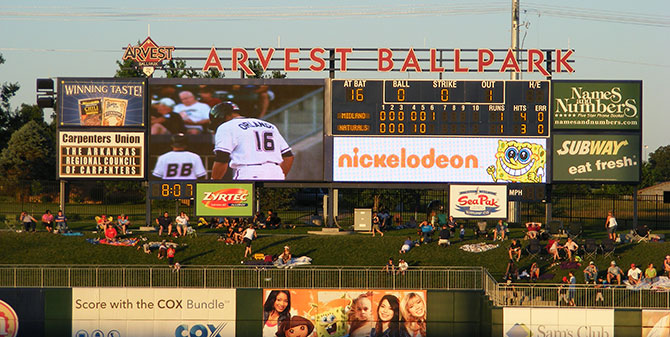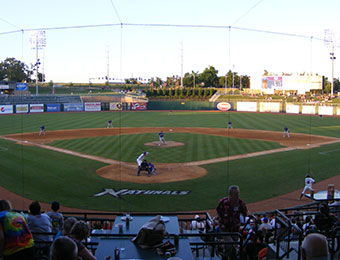Baseball in NW Arkansas
by Andrew Kulyk & Peter Farrell


Rich-owned team in Springdale has Buffalo roots
Northwest Arkansas is a white-hot growth area, southward from Bentonville, the worldwide headquarters of Walmart, all the way down to Fayetteville and the University of Arkansas, and it is here in the middle in Springdale that professional baseball has landed.
Trying to find Arvest Ballpark, the new home of the AA Northwest Arkansas Naturals, don’t expect some downtown venue sitting amidst skyscrapers, or a neighborhood field tucked in amidst tightly woven residential side streets.
A small and nondescript sign directs you down 56th Street off the main highway, and you follow the road. A two-lane road. With no shoulders, and plenty of cow pastures. The cows are so close to the street one could pet them.
And there, amidst the lush and bucolic grass fields, and the cows, stands Arvest Ballpark, a limestone façade that is a slice of baseball heaven. “We expected this stadium to be the centerpiece of a multi-use development, but then we opened right when the recession hit, so right now everything surrounding the ballpark remains on the drawing board,” explains Eric Edelstein, the youthful general manager of the Northwest Arkansas Naturals.
The Naturals are one of three teams owned by Buffalo’s Rich Baseball. Few might remember that back in the 1980s, when Buffalo dared to dream about becoming a Major League Baseball expansion city, the Rich family went on a buying spree, not only bringing AAA baseball back to Buffalo in 1985 but then placing their AA team in Wichita, Kansas, and subsequently acquiring an A level team in the New York-Penn League. That team is now located in Jamestown.
The Wichita Wranglers played at aging and crumbling Dumont Stadium, which also had the misfortune of having a dual grass and artificial turf field, among its other lack of amenities. With the political will lacking to fund a replacement venue, it was time for other options.
The Springdale area was more than willing to welcome the Riches to Arkansas, even voting to extend a supplemental sales tax to make Arvest Ballpark a reality.
The results have been stunning. The ballpark, an eco “green” facility, is designed with a natural stone and limestone face, with stone accents prevalent throughout the ballpark, all mined locally. The sweeping single-level concourse sits right on top of the action, with concessions and service stands located well off to the back of the corridors, keeping fans in the game from every vantage point. The second level of suites and press facilities are actually constructed gondola-style over the top of the concourses, and are uniquely detached from the structure itself. Sail-shaped canopies provide an attractive roof cover, and are illuminated from underneath at night.
On the outfield, lawn seating and a bullpen café group picnic area provides other viewing options, along with an ample children’s play area, which includes a miniature ball field with dirt basepaths, and plenty of room to run around and have fun. A large video board, dot matrix board, and scoreboard dominate the right center wall.
As to the Buffalo connections? Well, it’s subtle stuff that only hardscrabble pros would pick up on, but they are there. In addition to Edelstein, who worked for the Bisons sales staff a few years back, George Sisson, who worked his way up in Rich Baseball from Jamestown, is the team’s director of stadium operations. Former Buffalonian Justin Cole serves as the assistant general manager.
Then there are the other touches: The team nickname, gleaned from a name-the-team contest playing on Arkansas as “The Natural State,” has a secondary meaning to Buffalonians, as the epic movie, The Natural, was largely filmed in Buffalo. The home uniforms bear a similar look to those of the Bisons, as do elements of the game day experience, from the music bumps and chants to the line score portion of the scoreboard, which looks exactly like the one at Coca Cola Field, to the press notes, which have an identical masthead to the ones put together by the Bisons crew.
So we went in search of Buffalo food. It was only a matter of time before we’d find the deep fryers and our chicken wings served up with blue cheese and celery, right? Certainly our quest would land a Rich’s dessert cart with chocolate éclairs and frozen taste treats. Maybe a Red Osier stand.
Alas! That search was unsuccessful. About as close as we got was a fried bologna sandwich, but this was not the Buffalo version served on an egg roll and smothered in fried peppers and onions. Here they do it grilled cheese style, with the fried bologna served on toasted bread with melted cheese. “Much of the influence of our food presentation came from [Bisons president] Jon Dandes,” Edelstein says. “We use a fine dining firm named the Patina Restaurant Group and this is their only sports ballpark. We really didn’t want to extend the Buffalo cultural experience to Arkansas, which is a different market.”
Off to the right field corner is the best food stand in the place—a barbecue concession offering beef brisket, turkey legs, and pulled pork sandwiches. “It’s one of our fan favorites,” Edelstein says. “There’s much more to preparing barbecue than just throwing meat on a grill. There is an art to all this.”
For the seasoned veteran staffers of the Buffalo Bisons, who were with the team when then Pilot Field was built and unveiled in the 1980s, becoming an integral part of the planning for Arvest Ballpark provided a chance to go back in time and do it all over again. Dandes and Bisons general manager Mike Buczkowski have been with the team for the entire Bisons modern era, and Buczkowski remembers those days well. “What really took us back to those days was when we named the architect,” he says. “We had a chance to interact with the architectural firm Populous [formerly HOK Sport], and that gave us the opportunity to provide a great deal of input in terms of what we learned these past 20 years.
“So much of the business of baseball has changed since then. Back then, merchandising wasn’t such a big deal as it is today, thus the smaller-sized team store at our park. Player facilities, such as weight rooms and indoor batting cages weren’t a requirement then.”
Edelstein served as general manager of the Wichita Wranglers but was assigned to Springdale a year ahead of the team’s arrival, to plan for the franchise’s seamless move into a new market and a new ballpark. “It was an absolute team effort,” says Edelstein. “Jon Dandes and Mike Buczkowski spent a lot of time with the architects and our local experts and baseball experts to make sure everything was done right. I was amazed at the energy that [Dandes] brought to this effort. He would outlast many of us.”
While Springdale doesn’t have the tall towers of a bustling city, this region of northwest Arkansas has a burgeoning population. “People are moving into that area from bigger cities, and they are looking for amenities and entertainment options and things to do,” says Buczkowski. Edelstein adds, “Think of this community as Western New York without Buffalo. Lots of towns, lots of Main Streets, and they are all brought together with a regional identity.”
In their third year at Arvest Ballpark, the Naturals are still a hit, with group sales augmenting season tickets as crowds continue to come experience their ball team. “I cut my teeth in this organization,” says Edelstein. “We have always prided ourselves in offering a superior baseball experience, and I think we deliver that here in Arkansas. I know I’m biased, but this really is just about the perfect ballpark.”
blog comments powered by Disqus|
Issue Navigation> Issue Index > Summer Guide: week of June 10, 2010 > Baseball in NW Arkansas This Week's Issue • Artvoice Daily • Artvoice TV • Events Calendar • Classifieds |









 Current Issue
Current Issue